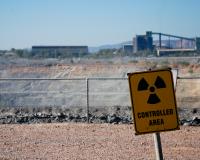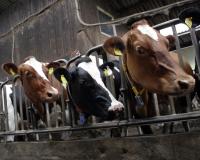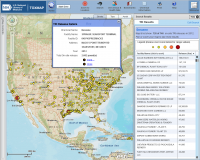
Vibrant Environment
All
All | Biodiversity | Climate Change and Sustainability | Environmental Justice | Governance and Rule of Law | Land Use and Natural Resources | Oceans and Coasts | Pollution Control

Indigenous communities in the Southwestern United States have been battling the impacts of uranium mining since the early 1940s. The geology of the Colorado Plateau was found to be rich in the radioactive mineral and drew mining to the area. The U.S. Department of Energy (DOE) sought uranium to develop nuclear weapons during the Cold War, which fueled the interest of mining companies that opened uranium mines and mills on and around indigenous land.

With the sweeping and difficult changes brought on by the COVID-19 pandemic, including social distancing and an economic downturn with record-high unemployment, greenhouse gas (GHG) emissions have plummeted globally. Reductions in emissions for the year are projected to be between 4% and 7% globally and between 6.7% and 11% in the United States.

The coronavirus pandemic is affecting a variety of industries, from travel to retail to restaurants. But perhaps the hardest-hit are meat and poultry processing plants, which have been experiencing outbreaks throughout the United States. In April, President Trump issued an Executive Order declaring these plants “critical infrastructure” to make sure they stay open, and the number of cases in these plants continued to rise in the days and weeks that followed. According to the Midwest Center for Investigative Reporting, as of June 15 there have been over 25,000 reported positive cases tied to meatpacking facilities in at least 235 plants in 33 states, and at least 90 reported worker deaths at 39 plants in 24 states.

The coronavirus pandemic is affecting a variety of industries, from travel to retail to restaurants. But perhaps the hardest-hit are meat and poultry processing plants, which have been experiencing outbreaks throughout the United States. In April, President Trump issued an Executive Order declaring these plants “critical infrastructure” to make sure they stay open, and the number of cases in these plants continued to rise in the days and weeks that followed. According to the Midwest Center for Investigative Reporting, as of June 15 there have been over 25,000 reported positive cases tied to meatpacking facilities in at least 235 plants in 33 states, and at least 90 reported worker deaths at 39 plants in 24 states.

The coronavirus pandemic is affecting a variety of industries, from travel to retail to restaurants. But perhaps the hardest-hit are meat and poultry processing plants, which have been experiencing outbreaks throughout the United States. In April, President Trump issued an Executive Order declaring these plants “critical infrastructure” to make sure they stay open, and the number of cases in these plants continued to rise in the days and weeks that followed. According to the Midwest Center for Investigative Reporting, as of June 15 there have been over 25,000 reported positive cases tied to meatpacking facilities in at least 235 plants in 33 states, and at least 90 reported worker deaths at 39 plants in 24 states.

The coronavirus pandemic is affecting a variety of industries, from travel to retail to restaurants. But perhaps the hardest-hit are meat and poultry processing plants, which have been experiencing outbreaks throughout the United States. In April, President Trump issued an Executive Order declaring these plants “critical infrastructure” to make sure they stay open, and the number of cases in these plants continued to rise in the days and weeks that followed. According to the Midwest Center for Investigative Reporting, as of June 15 there have been over 25,000 reported positive cases tied to meatpacking facilities in at least 235 plants in 33 states, and at least 90 reported worker deaths at 39 plants in 24 states.

To address environmental inequity, we first need to understand where inequity exists geographically. Maps help model our reality and are a useful tool for locating and addressing environmental inequity. The power of maps in environmental justice was first revealed in 1987 in Toxic Wastes and Race in the United States, published by the Commission on Racial Justice.

On June 4, President Trump signed an Executive Order entitled “Accelerating the Nation’s Economic Recovery from the COVID-19 Emergency by Expediting Infrastructure Investments and Other Activities.” The Order notes that in his March 13 declaration of a national emergency related to the pandemic, the President had invoked “national security” under the National Emergencies Act, 50 U.S.C. 1601 et seq., and “an emergency of nationwide scope” under the Stafford Act, 42 U.S.C. 5191(b).

Pandemics are global in nature, but their impacts are anything but uniform. COVID-19 is exposing substantial inequities, including disproportionate health and economic consequences for minorities. From medical care to broadband, different demographics have vastly different access to critical resources in a widespread crisis. Indian country is especially hard hit by coronavirus. It is the locus where matters of public health, Indigenous sovereignty, and environmental justice collide. Access to clean, safe, and affordable water offers a particularly stark example. Without water, even following the common sense admonition to frequently wash one’s hands becomes an insurmountable challenge.

In his 2019 article, Governing Extinction in the Era of Gene Editing, Prof. Jonas J. Monast of the University of North Carolina School of Law recommends using the Endangered Species Act (ESA) framework to regulate the growing use of gene-editing technology.